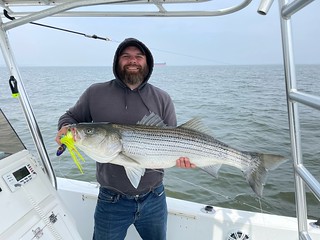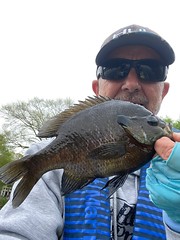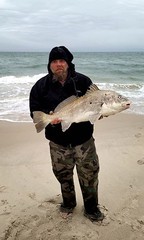Maryland Fishing Report – May 11
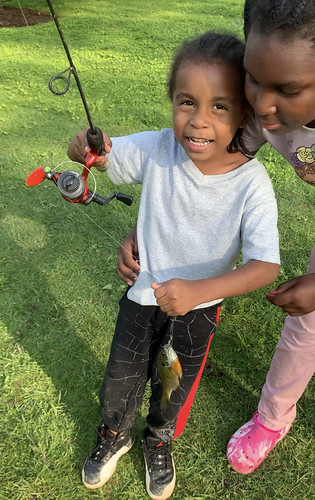
Angler Alonzo Magee caught his first fish — a bluegill — in a Gaithersburg pond. Photo by Leroy Hyson
The big story recently was a major storm system with heavy rains and northeasterly winds, which brought flooding conditions to the Potomac, Susquehanna, and other rivers and streams across Maryland. Fishing conditions should slowly get back to normal with a stretch of warmer sunny days and lighter winds. The shad run should continue until late May, and the 2022 striped bass trophy season will run through May 15. Summer season regulations start on May 16 – be sure to check the DNR website for seasonal regulations in your area of the Bay.
With the weather improving the next few days, don’t forget to take your kids out on the water and introduce them to the great sport of fishing!
Forecast Summary: May 11 – May 17:
Mild and periodically windy and wet conditions this week will lead to slightly warmer but turbid Bay waters. Maryland rivers are currently running in the mid to upper 50s.
Chesapeake Bay surface water temperatures have decreased since last week to the upper 50s, and will likely be in the mid-60s for the start of summer striped bass season on May 16. There is plenty of oxygen for Bay fish from surface to bottom.
Expect above average flows due to recent and predicted rains. Expect decreasing water clarity for most of the main Bay as well as many rivers and streams following the rains. In addition, expect reduced water clarity from algal blooms in the Tolchester area of the main Bay as well as the Bush, Gunpowder, Back, upper Patuxent and middle Potomac River from Colonial Beach down to Piney Point.
To see the latest water clarity conditions, check Eyes on the Bay Satellite Maps on the Maryland Department of Natural Resources website.
There will be above average tidal currents Thursday through Tuesday as a result of the upcoming full moon on May 16.
As always, best fishing areas could be further refined by intersecting them with underwater points, hard bottom, drop-offs, and large schools of baitfish.
For more detailed and up-to-date fishing conditions in your area of the Bay, be sure to check out Eyes on the Bay’s Click Before You Cast.
At the Conowingo Dam, heavy rains caused spill conditions, and anglers will have to wait for the river levels to come down before they can get back to catch-and-release fishing for American and hickory shad in the lower Susquehanna River, Deer Creek, and Octoraro Creek. Access to Fisherman’s Park at Conowingo Dam will be limited until waters recede.
With the high and murky flood waters, shad anglers should use a combination of a shad dart and a small gold or silver spoon in tandem. Gold spoons tend to work best in cloudy water conditions. As always, experienced shad anglers carry a variety of colors and weights to adapt to changing river conditions. It may take a few days for river and stream conditions to improve.
Blue catfish are still a reliable target species – many are fairly large – and can be found in almost every part of the upper Bay, including in murky waters after rains, with some white and channel catfish mixing in. We advise using stout tackle, a sinker heavy enough to hold bottom, and circle hook rig baited with fresh cut bait of menhaden, gizzard shad, chicken liver or breast, clam snouts, or other catfish baits that can be purchased at local tackle shops.
Prior to the weekend storm, fishing for white perch in the upper Bay’s tidal rivers had been steady, but the perch are not located along Bay shorelines yet. The white perch had moved to the middle and lower river sections. Fishing with bottom rigs baited with grass shrimp or pieces of bloodworm, or small jigs tipped with grass shrimp or bloodworm, will produce perch.
Fishing for northern snakeheads is improving as warmer water temperatures cause the fish to be more active, and they will strike bass-style lures. This invasive species can be found in every tidal river and creek in the upper Bay and the Susquehanna Flats. Casting white or chartreuse paddle tails, frogs, and buzzbaits are popular methods. Rigging a lip-hooked large minnow under a bobber can work well when the snakeheads are not striking artificial lures. All the rivers, coves, and tributaries around the north side of Baltimore, Essex, and Dundalk, including Dundee Creek, the Gunpowder, Bush, and Back rivers are good areas to target snakehead.
The 2022 spring trophy striped bass season runs until May 15. Upper Bay anglers need to remember that they can only fish for striped bass below the Brewerton Channel. The 2022 striped bass regulations are on the DNR website.
Trolling large bucktails and parachutes along the shipping channel edges near Podickory Point, the Dumping Grounds, and near the Bay Bridge is the most popular method for catching large trophy striped bass in the upper bay. The minimum size for fish to be kept is 35 inches, with a limit of one fish per angler per day. If you chum or chunk for striped bass, you must use non-offset circle hooks, and fishing with live eels is not allowed. The beach at Sandy Point State Park and the Matapeake Fishing Pier will be popular places for shorebound anglers to fish with bait.
Striped bass anglers in the middle Bay are reminded that during trophy season, through May 15, striped bass fishing is only allowed in the main stem of the Bay; the tidal rivers are still closed.
Anglers had fair success with striped bass prior to the heavy rains and northeast winds with some very large striped bass in the 40-inch to 50-inch range, from the Hill off Kent Island south to the gas docks area. Good areas to target trophy striped bass until May 15 are the steep channel edges at the False Channel, RN2, and the steep channel edge south to the CP Buoy. The steep channel edges near Bloody Point, Buoy 83, and the western shore shipping channel edges from Thomas Point south past Breezy Point are always good places to troll.
Large parachutes, bucktails, and Mojos with large 9-inch sassy shads in white or chartreuse rigged in tandem or behind umbrella rigs are the best trolling lures for striped bass. Chartreuse colors tend to work better in the turbid and muddy waters that we are currently experiencing in many parts of the Bay. Heavy inline weights are used on the deep lines, and unweighted tandem rigs will cover the top waters. At dawn, it is common for the large striped bass to be close to the surface, but boat traffic and bright sunlight will eventually drive them deeper in the water column.
Light-tackle jig and fly anglers enjoyed some success for striped bass during the first week of May. Good areas for light tackle and fly casting include Eastern Bay, Poplar Island, and any areas where striped bass are suspended near channel edges. The warm water discharge plume at the Calvert Cliffs Nuclear Power Plant will most likely produce fish on jigs for the rest of May. Large soft plastic jigs in the 7-10 inch range on lead heads are used to target medium and large striped bass. Chunking for striped bass near Dollys Lump or Hackett’s Bar will produce some large striped bass, but you must use non-offset circle hooks.
Good fishing for blue catfish in the tidal rivers should continue. The Choptank River and Nanticoke River are both good areas for targeting this invasive species. Cut menhaden or gizzard shad are excellent baits, while chicken liver, breast meat or clam snouts can also work well.
As a reminder, the fishing piers at Bill Burton Fishing Pier State Park remain closed in both Dorchester and Talbot counties due to structural safety concerns. Shoreline and trail access is open on the Talbot County side of the park. More information is available on the DNR website.
White perch have moved down to the middle and lower sections of the region’s tidal rivers, but you may have to wait a few days for river conditions to stabilize after the heavy rains. Bottom rigs baited with grass shrimp or pieces of bloodworm are working the best in deeper waters, especially when fishing from shore. Small jigs tipped with grass shrimp or pieces of bloodworm can work also when fishing near structure, docks, and piers.

Brian Bokulic was fishing the marshes near Crisfield and caught four speckled trout. Photo by Brian Bokulic
Striped bass trophy season will continue until May 15, and when the wind and wave conditions improve on the lower bay, anglers will be trolling along the steep edges of the shipping channels with large parachutes, bucktails, and Mojos dressed with large sassy shads. As usual, planer boards tend to produce more strikes by deploying a wide trolling spread, along with a few flat lines fished directly off the stern.
Traditional areas to troll until mid-May for large striped bass will be the channel edges at Cove Point, Cedar Point, Point No Point, and Smith Point on the western side of the bay. On the eastern side, areas include the steep channel edges from the CP Buoy south to Buoy 76, 72B, and the main channel down the center of Tangier Sound. In the lower Potomac River, the steep channel edge from Piney Point to St. Georges Island and Point Lookout will be good bets for trolling action.
Striped bass are typically swimming close to the surface during early morning hours, and boat traffic will drive them deeper in the water column during the day. Surface water temperatures are warmer than deeper waters so it is often a preferred space for striped bass in the spring.
We had some exciting news that the first speckled trout of the year had shown up along the lower Eastern Shore marshes and shorelines, and they were being caught on paddle tails by kayak anglers. That fishery should improve as waters warm in the lower Bay.
Blue catfish will continue to offer fun fishing in the tidal rivers through May, and anglers can participate in a conservation effort to help diminish this invasive fish and their predatory effects on native fish populations.
Northern snakeheads are another invasive fish that has spread across every tidal river in Maryland. This is an aggressive predator that feeds on native fish populations. The tributaries to the Potomac River tend to hold some of the largest concentrations of snakeheads. The upper Patuxent River and the rivers and creeks of southern Dorchester County on the Eastern Shore are a close second. Lately anglers have been having good luck casting frogs over patches of grass, and white or chartreuse paddle tails rigged weedless are always a popular bait. A large minnow rigged under a bobber is also a good tactic when lures are not producing.
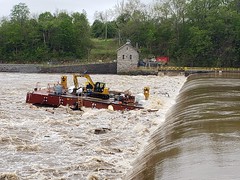
In the Potomac, two barges broke loose from their construction sites and drifted downstream in the floodwaters. Department biologist John Mullican happened to be at Dam 4 – which is 23 feet high – when the barges went over. Photo by John Mullican, Maryland Department of Natural Resources.
After the heavy weekend rains, Potomac River levels remain high and most rivers and streams have not been fishable. Boaters should use caution as most ramps will be coated with river mud, which is extremely slippery.
Largemouth bass are close to spawning or have already started in most Maryland waters. Small ponds usually warm up first, followed by larger bodies of water and tidal rivers and creeks. The males have carved out spawning beds in the shallow areas and the females are either on the beds or staged nearby in slightly deeper water. Targeting the largemouth bass that are holding in the deeper waters can be accomplished with small crankbaits, spinnerbaits, jerkbaits, and soft plastics. Any kind of structure such as sunken wood or deep grass are good places to target. There have also been some nice bluegill caught in small ponds and lakes.
Fishing for crappie should be a good bet until waters become too warm; the cooler water temperatures allow the crappie to freely move in a variety of water depths. Structure is often the key – fallen treetops, sunken wood and brush, or marina docks are good places to look for crappie. Small marabou jigs or minnows under slip bobber, or casting jigs with a very slow retrieve are traditional methods for crappie.
Fishing along the coastline was difficult, if not impossible this past weekend due to northeast winds of 25-35 mph with gusts above 45 mph; the ocean most likely will not be fishable for the next few days. Also, the bay will probably be turbid with weeds and sediment after the passing of the storm system, making flounder fishing difficult. A few brave souls ventured out and fished the surf and caught some large striped bass in the 30-40 inch range, along with a few black drum, before the sea and surf conditions became too turbulent.
A few bluefish have shown up in the surf and the Ocean City inlet, but we have not heard of very large numbers of these toothy fish yet. Prior to the storm there was some good action on black drum in the surf. Local surfcasters are catching black drum on sand fleas and clams. The clams are fastened to a 7/0 circle hook with dental floss or rubber bands. Clearnose skates continue to be pesky bait stealers, with some spiny dogfish in the mix. Anglers targeting bluefish should use cut or whole finger mullet, or cut menhaden.
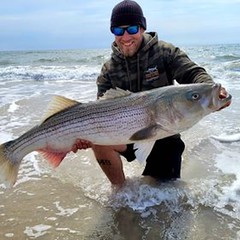
Morgan Mericle hit the Assateague Surf on May 6 in northeast winds and had a great day on striped bass and drum. Morgan caught three big striped bass up to 45 inches, his personal best. Photo courtesy of Scott Lenox
Tautog season runs through May 15, and until then they can still be caught on sand fleas and crab baits along the inlet jetties, the Route 50 Bridge piers, and nearby bulkheads. Prior to the rough weekend weather, flounder were being caught in the inlet and Route 50 Bridge area, the Thorofare, and the channels leading from the inlet. The channels in Assawoman Bay and Sinepuxent Bay also provide good flounder fishing opportunities, but we may have to wait a few days for water conditions to clear. When conditions improve, soft plastics such as Gulps will catch flounder as well as squid strips and minnows.
Tautog fishing was fair to good on the offshore wreck and reef sites, prior to the storm, but heavy northeast winds will keep most boats tied at the dock or fishing in the back bays for the next few days.
Black sea bass season will open on May 15.
“I fish to scratch the surface of those mysteries, for nearness to the beautiful, and to reassure myself the world remains.” – Carl Safina
Maryland Fishing Report was written and compiled by Erik Zlokovitz of Maryland DNR Recreational Fisheries Outreach, filling in for Keith Lockwood.
Click Before You Cast is written by Tidewater Ecosystem Assessment Director Tom Parham.
This report is now available on your Amazon Echo device — just ask Alexa to “open Maryland Fishing Report.”


